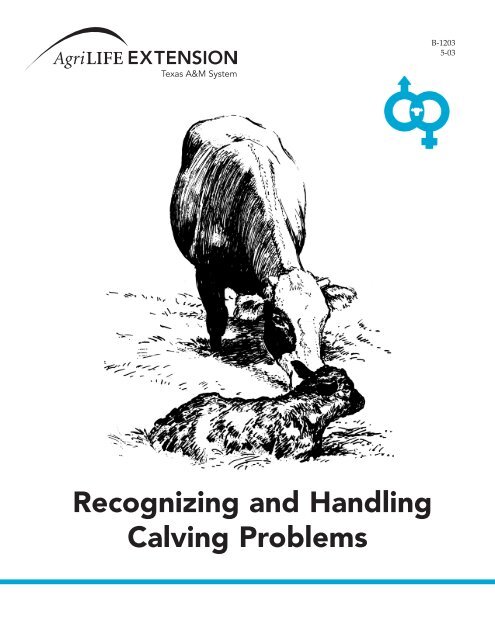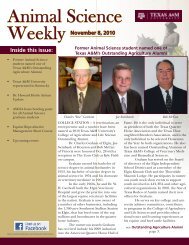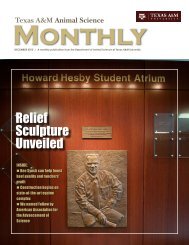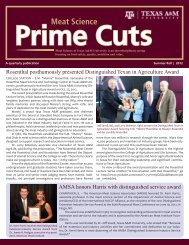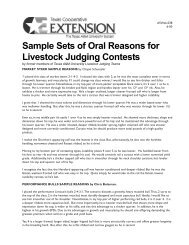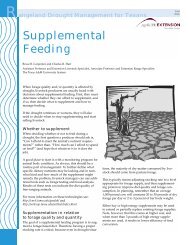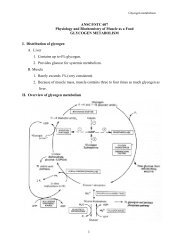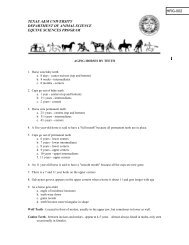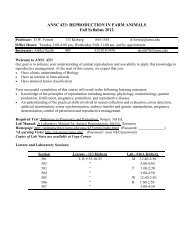Recognizing and Handling Calving Problems - Department of ...
Recognizing and Handling Calving Problems - Department of ...
Recognizing and Handling Calving Problems - Department of ...
You also want an ePaper? Increase the reach of your titles
YUMPU automatically turns print PDFs into web optimized ePapers that Google loves.
HIPBONESACRUMPINBONEPELVIC RIMFigure 3. Skeletal structure <strong>of</strong> the cow.SACRUMAllantochorionicmembraneAmnionic membranePINBONEFetal cotyledonPELVIC RIMFigure 4. Side view <strong>of</strong> the pelvic bone <strong>of</strong> the cow. Arrows indicatethe guiding line or pelvic axis followed by the calf at birth.intact. It may protrude as a water bag filled with darkamber fluid. Occasionally the membrane breaks before itbecomes visible. Then it is observed simply as a sudden<strong>and</strong> large expulsion <strong>of</strong> straw-colored fluid rushing fromthe vagina. This is followed by the amnion or water sac,which is the membrane immediately surrounding thecalf. The amnion is a white, clear membrane, in comparisonwith the allantochorion which is a darker color.Appearance <strong>of</strong> the amnion or feet beginning to protrudethrough the vulva marks the beginning <strong>of</strong> the deliverystage. Ordinarily, birth occurs within 30 minutes to 4hours after the amnion or feet are first visible. Althoughthe time limits specified for stage 2 are accepted norms,Figure 5. A young calf enclosed in the complete fetal membranes.Note the amnion immediately surrounding the calf <strong>and</strong>the allantochorion which covers the amnion <strong>and</strong> extendsthroughout both horns <strong>of</strong> the uterus. Spots on the surface <strong>of</strong> theallantochorion are villi <strong>of</strong> the fetal cotyledons which pull awayfrom the maternal caruncles when the fetus is removed from theuterus.remember that if a cow is moved during early labor or inthe early stages <strong>of</strong> active labor she may actually delaycalving. Excitement <strong>and</strong> nervousness in cows may temporarilyweaken uterine contractions. Thus, whenobserving cows during stage 2, consider any movementor undue excitement <strong>of</strong> the cows when determining thelength <strong>of</strong> delivery.STAGE 2 OR DELIVERY STAGE is the time <strong>of</strong> expulsion<strong>and</strong> actual delivery <strong>of</strong> the calf. In normal deliveries,this stage lasts from 30 minutes to 4 hours, but may belonger in young heifers. Early symptoms are recognizedeasily. The second stage begins with the movement <strong>of</strong> thecalf’s head <strong>and</strong> feet into the birth canal <strong>and</strong> the entrance5
sloughing <strong>of</strong> the hair or foul odors may indicate the calfis dead.As the next step in the examination, determine thepresentation, position <strong>and</strong> posture <strong>of</strong> the calf.Presentation describes the relative direction <strong>of</strong> delivery.The calf may be presented frontwards, backwards orcrosswise to the pelvic opening.Position describes how the calf is lying. The calf maybe upside down, right side up, or have its back to eitherside <strong>of</strong> the pelvic canal <strong>of</strong> the cow.Posture indicates the location <strong>of</strong> the legs, head <strong>and</strong>neck. If the calf is presented frontwards, one or bothforelegs may be turned back or the head may be down<strong>and</strong> the feet in correct position. A fetus in a backwardspresentation may have one or both hindlegs flexed at thehock or hips.Figure 6. Posterior presentation with rear legsextended under the calf’s body (breech presentation).May be corrected by pushing the calf forward<strong>and</strong> grasping the legs one by one. As eachleg is drawn into the birth canal, keep the hockpointed toward the cow’s flank <strong>and</strong> the ho<strong>of</strong> tothe midline (see detail in Figure 9).Figure 8. Posterior presentation <strong>of</strong> the calf. Deliverymay <strong>of</strong>ten proceed without complications.Assistance may be important if labor is prolonged.Death <strong>of</strong> the calf can occur due to rupture <strong>of</strong> thenavel cord <strong>and</strong> subsequent suffocation.Figure 7. Normal anterior presentation, position <strong>and</strong>posture <strong>of</strong> the calf before delivery.Figure 9. Correction <strong>of</strong> the hock flex in posterior presentation.The calf is first pushed forward. The h<strong>and</strong> grasps <strong>and</strong> cups thecalf’s foot, then draws it back as the hock is flexed. The foot inthe cupped h<strong>and</strong> is lifted over the pelvic rim <strong>and</strong> into the vagina.An alternated method in more difficult cases is to place a snarearound the pastern, attached at the front <strong>of</strong> the leg. The snare isthen pulled between the digits <strong>of</strong> the foot so that when tractionis applied the fetlock <strong>and</strong> pastern are flexed. The calf is pushedforward <strong>and</strong> the foot is guided over the pelvic rim as an assistantpulls the snare.7
Figure 10. Correction <strong>of</strong> a simple leg flexion in an anteriorpresentation. The calf is first pushed forward <strong>and</strong> theretained foot is grasped in the cupped h<strong>and</strong>. The foot iscarried outwards <strong>and</strong> then forward in an arc over thepelvic rim. More difficult cases may require that a snare beattached to the retained fetlock to help extend the leg.Figure 12. Anterior presentation with the head <strong>and</strong>neck turned back over the body. Secure the legs withchains. Push the calf back into the body. This <strong>of</strong>tenbrings the head into normal position (see Fig. 13).Figure 11. Anterior presentation with the rear legs extendedbeneath the body (dogsitting posture). A very serious type <strong>of</strong>malpresentation. If allowed to progress into advanced labor, fetaldeath may result. Early pr<strong>of</strong>essional attention may be required.The normal presentation <strong>of</strong> the calf (Fig. 7) is frontwards.Although a calf can be pulled in a backwardspresentation (Fig. 8), there is some danger. The normalposition <strong>of</strong> the calf is back side up. Never pull a calf inany other position because the chances <strong>of</strong> killing both thecow <strong>and</strong> calf are great. The correct posture <strong>of</strong> the fetus iswith both front legs outstretched in the birth canal <strong>and</strong>with the head <strong>and</strong> neck extended along the legs. Correctany deviation from this posture before the calf is extracted(Figs. 9 through 16). About 95 percent <strong>of</strong> all birthsoccur with normal presentation, position <strong>and</strong> posture.Determining the relative size <strong>of</strong> the calf <strong>and</strong> birthcanal is the next step in examination. This is a criticaljudgment <strong>and</strong> requires some experience. Forcing a largecalf through a small pelvic opening almost invariablyresults in death <strong>of</strong> the calf as well as injury, paralysis oreven death <strong>of</strong> the cow. If it is fairly certain the cow willhave serious calving difficulties, call a veterinarian. Once8
Assistance is first begun by attaching the obstetricalchains to the front legs. Don’t put a single loop <strong>of</strong> thechain around both front legs. Instead, use a double loopon each leg (Fig. 17). Place the first loop about 4 inchesabove the ankle joint <strong>and</strong> dew claws. Next, form a halfhitch about 2 to 3 inches down the leg, but above theankle joint. If the chain is around the ankle below thedew claw a leg may be broken or a ho<strong>of</strong> pulled <strong>of</strong>f. Besure to position the loops so that one pulls from the back<strong>of</strong> the legs. A chain on the front or sides causes a twistingaction that may break bones. Normally in forced extractions,the force exerted by one or two persons in pullinga calf is safe <strong>and</strong> sufficient. Never use fence stretchers,tractors, trucks or other devices which may applyextreme force. If additional extractive forces are necessary,a mechanical calf extractor is the only safe means.It usually is best to pull both legs with even pressure. Ifthe pelvic opening <strong>of</strong> the cow or heifer is small, pull thelegs alternately until the shoulders are eased through thebirth canal. Then continue applying pressure to bothlegs. Don’t hurry the cow. As the calf moves through thebirth canal, the cow’s natural body mechanisms are helpingby letting this area dilate.One cause <strong>of</strong> calf deaths <strong>and</strong> damage to heifers ishiplock. This is a situation in which the calf’s hips won’tpass through the cow’s pelvic opening. Some cases <strong>of</strong>hiplock may require veterinary assistance. Proper traction<strong>of</strong>ten prevents or eases this problem by keeping thecalf’s hips high as they pass through the pelvic opening,thus taking advantage <strong>of</strong> the widest horizontal part <strong>of</strong> thecow’s pelvis. Pull the calf out <strong>and</strong> down at a 45 o to 60 oangle. As the front legs come through the vulva, increasethe traction in a downward direction with the calf’s legspractically parallel with the cow’s legs.If this does not help, release the calf puller or tensionon the chains <strong>and</strong> push the calf back far enough torelieve the lock up. Then rotate the calf clockwise orcounter-clockwise to get a new angle for the hips to passthrough the cow’s pelvis. This technique works becausethe vertical axis <strong>of</strong> the pelvis is greater than the horizontalaxis (Fig. 18).Another method used for hiplock is to rotate the calf<strong>and</strong> then swing the shoulders <strong>and</strong> front feet to the cow’sside. Put the pulling chains around the calf’s barrel <strong>and</strong>pull gently to avoid injuring the calf’s spinal cord. Thisprocedure <strong>of</strong>ten allows one hipbone at a time to easethrough the cow’s pelvis. In this procedure the barrel <strong>of</strong>the calf is pulled to the rear <strong>and</strong> down while the front feetare swung up <strong>and</strong> to the side.HIPBONESACRUMPELVIC RIMFigure 18. Front view <strong>of</strong> the pelvic bone <strong>of</strong> the cow. Notice thatthe vertical width exceeds the horizontal width <strong>of</strong> the birth canal.HELPING THE CALFAs the calf is delivered, it passes through the vulva <strong>and</strong>the short umbilical or navel cord usually breaks. Survivalis then dependent upon functioning <strong>of</strong> the calf’s lungs<strong>and</strong> initiation <strong>of</strong> body activity. Once the navel cord isbroken, the placental supply <strong>of</strong> oxygen is cut <strong>of</strong>f. Oxygenin the blood <strong>of</strong> the calf drops rapidly <strong>and</strong> the carbondioxide level increases. These changes stimulate the respiratorycenters <strong>of</strong> the brain <strong>and</strong> cause the calf to struggle<strong>and</strong> gasp. As the calf gasps, the lungs fill with air <strong>and</strong>oxygen deficiency is rapidly overcome.Occasionally a calf has trouble breathing after delivery.In such instances it is important to quickly clear themouth <strong>and</strong> nose <strong>of</strong> mucus. If the calf continues to havetrouble breathing, pick him up by the hind legs <strong>and</strong>swing him back <strong>and</strong> forth or around to dislodge themucus. This procedure may sound harsh, but can bevery effective. Rubbing or scratching the inside <strong>of</strong> thecalf’s nostrils with a straw irritates the delicate tissues <strong>and</strong><strong>of</strong>ten causes the calf to sneeze or cough, thereby clearingout the breathing passages.Artificial respirators are available <strong>and</strong> can be <strong>of</strong> greatassistance, especially for producers <strong>of</strong> valuable registeredstock. If no respirator is available, clean <strong>of</strong>f the calf’smuzzle <strong>and</strong> blow your own breath into the calf’s nostril.Another alternative is to place a short section <strong>of</strong> 3 /4-inchgarden hose in one nostril. The mouth <strong>and</strong> other nostrilare then clasped so that air can enter <strong>and</strong> leave the calfonly through the nose. Blow into the nose <strong>and</strong> allow theair to be exhaled. Repeat every 6 to 7 seconds until thecalf starts breathing, or until his heart stops beating. It isimportant to remember that the baby calf’s lungs areconsiderably smaller than a human’s <strong>and</strong> care should be10
taken not to over inflate <strong>and</strong> rupture the lungs. Results <strong>of</strong>these resuscitation methods can be very dramatic.CARING FOR THE COWOne <strong>of</strong> the rancher’s main concerns about the heiferor cow is the possibility <strong>of</strong> retained placenta. Usually thefetal membranes are expelled within 8 to 12 hours. Leavethe cow alone until this occurs. Research shows thatmanual removal <strong>of</strong> the placenta, regardless <strong>of</strong> how pr<strong>of</strong>essionally<strong>and</strong> carefully done, can cause complicationsthat would not occur otherwise.In one <strong>of</strong> several studies, cows that received antibiotictreatments without removal <strong>of</strong> the membranes had a 79percent conception rate at first rebreeding. Manualremoval <strong>of</strong> the membranes without any drugs droppedthe figure to only 39 percent. When drugs were given<strong>and</strong> membranes removed manually, the rebreeding ratewas also 39 percent. Cows receiving no drugs <strong>and</strong> noassistance increased to 50 percent. Thus, removal <strong>of</strong> themembranes seems to be the deterring factor in uterinerecovery <strong>and</strong> rebreeding.Reports indicate that retained membranes occur in 5to 15 percent <strong>of</strong> births in healthy herds. Retained placentais common in premature <strong>and</strong> multiple births <strong>and</strong>when birth has been induced. Research also indicatesthat retained membranes occur more frequently in cowsproducing bull calves. Once retention <strong>of</strong> the membraneshas occurred, there is about a 20 percent chance <strong>of</strong> itsrecurring. A high incidence <strong>of</strong> retained membranes maybe associated with disease conditions in the herd <strong>and</strong>may require pr<strong>of</strong>essional attention. Most authoritiesagree that if a cow retains the membranes, you shouldnot initiate treatment until 48 to 72 hours after birth,unless the cow loses appetite or has an elevated temperatureor other signs <strong>of</strong> septicemia. Treatment generallyconsists <strong>of</strong> infusing the uterus with an inseminatingpipette placed through the cervix. Uterine infusion <strong>of</strong> 50to 100 milliliters <strong>of</strong> an oxytetracycline or chlorotetracyclinesolution is the preferred treatment. In addition,injections <strong>of</strong> penicillin/streptomycin are commonly givenfor 3 to 5 days. Females showing serious signs <strong>of</strong> septicemiashould be treated by a veterinarian.MAKING THE DECISIONWhen deciding whether or not to assist with calving,consider the circumstances. With mature cows it’s betterto wait than to start assistance too early because the cowusually takes care <strong>of</strong> her own problems. With heifers itmay be different. Their immature bodies are not fullydeveloped <strong>and</strong> pelvic openings may simply be too small.A minor problem may be created by assisting a heifer tooearly, but if one waits too long, any problem will be amajor one.<strong>Calving</strong> problems are most common in heifers givingbirth to their first calves. Only about 3 percent <strong>of</strong> maturecows have any trouble, but for heifers the figure may be50 percent or more. Table 1 illustrates the hourly returnto ranchers for time spent observing <strong>and</strong> assisting at calving.Notice that observation frequency is the key to savinga high percentage <strong>of</strong> calves. A single check for problemsis scarcely worth the effort, but returns per hour <strong>of</strong>time increase significantly as the cattle are observed morefrequently.In Texas, approximately 8 to 10 percent <strong>of</strong> all calvesborn in beef cow herds die at or soon after birth.Approximately three-fourths <strong>of</strong> these deaths are due tocalving difficulties. Losses due to calving difficulty costthe cattle industry three to four times more annuallythan costs resulting from abortions, <strong>and</strong> are second onlyto losses from cows failing to conceive. The only way toreduce such losses is through good management <strong>of</strong>heifers from weaning until first calving, frequent observation,<strong>and</strong> being ready to help when problems arise.Table 1. Cost <strong>and</strong> returns for checking a beef breeding herdat calving time for 50-cow herds.*Number <strong>of</strong> times checked each day1 2 3 4Total hoursexpended per cow .8 .9 1.0 1.2Returns fromadditional calves** $153.60 $307.20 $460.80 $614.40Total labor cost*** $240.00 $270.00 $300.00 $360.00Returns per hour (-$2.16) $0.83 $3.22 $4.24*Research data adapted from Ohio Agricultural ExperimentStation Circular 103.**Calf value at weaning – $384 for a 480-pound calf.***Labor valued at $6.00 per hour.SUGGESTED READINGB-1077 Determining Pregnancy in CattleB-1213 Management <strong>of</strong> Replacement Heifers for a High Reproductive <strong>and</strong> <strong>Calving</strong> Rate(both available at the Texas AgriLife Bookstore, http://agrilifebookstore.org)
Produced by AgriLife Communications, The Texas A&M SystemExtension publications can be found on the Web at: http://agrilifebookstore.orgVisit Texas AgriLife Extension at: http://agrilifeextension.tamu.eduEducational programs <strong>of</strong> Texas AgriLife Extension Service are open to all people without regard to race, color, sex, disability, religion, age ornational origin.Issued in furtherance <strong>of</strong> Cooperative Extension Work in Agriculture <strong>and</strong> Home Economics, Acts <strong>of</strong> Congress <strong>of</strong> May 8, 1914, as amended, <strong>and</strong>June 30, 1914, in cooperation with the United States <strong>Department</strong> <strong>of</strong> Agriculture. Edward Smith, Director, Texas AgriLife Extension Service, TheTexas A&M System.10M, Revision


